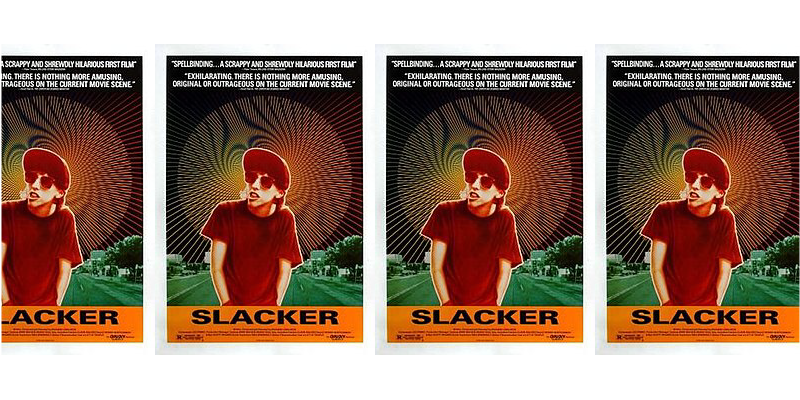And so the torch has been passed to a new generation, or so the story goes. This year, the last of the millennials and the first of Generation Z (or post-millennials or iGen or whatever name the culture decides on) are entering the workforce, and analysts, commentators, and critics are using this transition to reflect upon the changing landscape of work at the end of the second decade of the 21st-century. Many of these articles have made a large splash in the cultural conversation — Anne Helen Petersen’s “How Millennials Became the Burnout Generation” comes to mind — but the discussion has also made clear a certain cultural amnesia exists about these attitudes. Case in point: CBS News ran a story on Petersen’s piece accompanied by a graphic that completely omitted Generation X from its list of generations since 1928.
Such a gaffe from a major news organization may appear surprising; however, it becomes less of a shock when one considers that, for many, Gen-X is defined not by work but rather by its aversion to it. The culture even resurrected the word “slacker,” a term used in World War I to refer to draft dodgers, to characterize the so-called aimless, apathetic youth of the 1980s. However, one thing these recent examinations of work in America make clear is that the culture is paying a price for ignoring the work ethic of Generation X. Turns out Gen-Xers were not avoiding work at all but were attempting to change America’s conception of labor altogether.
The best example of Generation X’s attitude toward labor is also one of its most significant artifacts, right up there with Nevermind and Straight Outta Compton: Richard Linklater’s film Slacker. Today the film, which was shot 30 years ago in the once-small town of Austin, Texas, demands to be read as a treatise about labor in capitalist America. Even though hardly anyone in the film is gainfully employed and almost no money changes hands, Slacker and its many slackers do not shirk work: in fact, they are preoccupied with labor and its meaning. In appropriating the culture’s pejorative name for Generation X for the film’s title, Linklater transforms the word’s meaning, ardently calling for a revolutionary reimagining of work in his own affable, unassuming way. For Linklater, the most important work in life is also the work American society respects and values least; however, engaging in this work is the only way one can awaken from their workaday slumber and find meaning and freedom in this brave neoliberal world.
Linklater’s film captures 24 hours of Gen-Xers ambling, loafing, grifting, stealing, drinking, and — most of all — talking themselves in circles. Each scene transitions to the next in the most offhanded of ways: one character brushes shoulders with another, and the camera shifts its attention to that stranger. A few moments later, that character passes another character, the camera latches onto them, and so on in a La Ronde structure that never closes its loop, suggesting that the film could go on indefinitely. The film may seem as aimless as its characters, but its lack of direction is merely superficial: Slacker is a highly driven, rigorously linear film. The camera continually tracks alongside its characters like they’re detectives in some kind of grunge procedural. And these characters are trying to solve a mystery, and it’s one that confounds many today: in a dehumanizing world of McJobs and freelance gigs, where does one find meaningful labor?
In his book Kids These Days: Human Capital and the Making of Millennials, Malcolm Harris outlines how capitalism has “accelerated [at an] historically unprecedented pace of change” to become both “the single dominant mode of organizing society” and “visibly unsustainable.” Despite “producing some damn good workers,” capitalism uses productive labor to obliterate “the distinction between work-time and the rest of life” because time spent away from work is time that could be spent working (and earning profits for the bosses). According to Harris, millennials have been raised to be “highly attuned to the needs of capital markets” and “are encouraged to strategize and scheme to find places, times, and roles where [they] can be effectively put to work.” “Efficiency is [millennials’] existential purpose,” Harris writes, and they have become “a generation of finely honed tools, crafted from embryos to be lean, mean production machines.” Free time no longer exists in the neoliberal world Harris describes as workers continually seek ways to increase their productivity even as their wages plummet. Perhaps CBS News forgot about Gen X because slacking is not so much a dirty word as it is a word that has disappeared from the American imagination entirely. The culture might make it seem that no one can afford to stop working long enough to contemplate Slacker’s oppositional approach to labor, but the alarming developments Harris describes only emphasize that remembering and reflecting upon Slacker and its Gen X ideals are more urgent than when the film came out.
Linklater’s film strives to reclaim “slacker” from its negative connotations. As he states in an interview with Andrew Kopkind, slackers “are actually one step ahead, rejecting most of society and the social hierarchy before it rejects them.” Slackers do not shirk the obligations of life but fulfill them by, as Linklater says, “being responsible to themselves and not wasting their time in a realm of activity that has nothing to do with who they are or what they might be ultimately striving for.” As the character known as the Hitchhiker Awaiting, “True Call,” brags in the film, slackers like himself “may live badly, but at least [they] don’t have to work to do it.” Such a renunciation of work can be difficult for a work-obsessed nation to wrap its results-oriented head around. This preemptive rejection of traditional values may appear to regard nothing as being of value; however, such judgments fail to see that, as one character says, “withdrawing in disgust is not the same as apathy.” Renunciation is work, hard work. And, unlike other jobs, clocking out from it compromises one’s labor.  Slacker posits that material comfort in America will always be elusive and wanting, so why make oneself even more unhappy with a job that asks them to defer their search for meaning and purpose in life in exchange for money?
Slacker posits that material comfort in America will always be elusive and wanting, so why make oneself even more unhappy with a job that asks them to defer their search for meaning and purpose in life in exchange for money?
The near-total absence of the traditional working world from Slacker demonstrates how much the film seethes with disgust for the working stiff. The one character in the film with a so-called “career” is an attorney who, in the second scene of the film, gives his business card to a jogger at the scene of a fatal hit-and-run in a clear attempt to pick her up. The business card, the item that identifies a person by their job, becomes an instrument of sexual exploitation. This presentation of white-collar work is not exactly going to inspire anyone to sign up for the LSAT.
The buskers, bartenders, baristas, clerks, musicians, artists, writers, and filmmakers that populate Slacker’s American Bohemia may not go to work or earn much money, but they also don’t buy things. At least, not anything new. Most of the businesses depicted in Slacker sell either food or used goods. What characters don’t buy, they steal, rejecting labor, money, and the marketplace by refusing to pump more fuel into a machine that traps them in an alienating cycle where all they get for their work is simply more fuel to feed the machine that consumes their labor, ad infinitum. Harris’s book shows how this concern has grown even more pressing in the three decades since Slacker’s release. Although there is an overwhelming variety of products one can consume, Harris reminds readers that a consumer’s choices are “actually very limited” because there is no choice on the shelves that “opens a portal to a world where [people] don’t have to trade half [their] waking life to get enough to eat.” Thinking that making a purchase will improve the system in any way is the same as “stepping up to the plate and trying to throw a touchdown,” Harris says.
The only theft in the film that generates profit comes from a pack of feral tweens who rig a Coke machine to spit out sodas when dropkicked. They then sell the sodas to people on the street. (It’s a literal Kickstarter program.) Apart from the cash they accumulate, their actions produce absolutely nothing but capital. In fact, their work is meaningless and borders on destructive. When they’re not kicking soda machines, they’re bashing everything around them with sticks. The film credits these Junior Disruptors as “Budding Capitalist Youth,” illustrating a view of commodity exchange bleak enough to make Marx wince.
The Budding Capitalist Youth are not market disruptors — they’re simply culture’s most apt pupils who understand that, in Harris’s words, exploitation gives one “an unsurmountable leg up on the little guys.” They’re the youngest characters in the film, and Linklater uses them to demonstrate how early capital’s logic seeps into one’s mind. A scene later in the film unpacks this process further. The scene is a version of the once exciting, now-tiresomely-familiar drunken pop culture riff in which two grungebros unpack how Scooby-Doo indoctrinates kids in capitalist ideology by teaching them the art of bribery. Of course, Scooby and Shaggy are slackers avant la lettre: they’d always prefer not to, but they cannot resist the sweet siren song of Scooby Snacks. To get them to perform dangerous labor in each episode, Mystery Inc. negotiates with them until they agree upon a Scooby Snack compensation package. The grungebros see themselves in this no-win situation and bemoan how the programming they grew up on taught them that Scooby Snacks are the only thing worth working for before they were given a chance to consider (or even view) an alternative mode of living. In fact, the other program they dissect in their conversation, The Smurfs, explicitly tells children there is no alternative or at least none that won’t get them killed. Each episode of that show, they realize, instructs kids to stay with the pack, to not look for a better way to live because they live in the best of all possible worlds and they should never question it. Just fall in line, do your work, keep your head down, and eat your damn Scooby Snacks. Harris, perhaps following Linklater’s logic, also chooses a dog as a metaphor for how contemporary workers submit to the whims of capital in exchange for paltry Scooby Snacks: “like golden retrievers who don’t know how to stop chasing a ball, Millennials are so well trained to excel and follow directions that many of [them] don’t know how to separate [their] own interests from a boss’s or a company’s.” The precarious labor market of the 21st century has exacerbated this situation further by making young people believe “that work itself is a privilege of which they are probably unworthy,” making them so desperate to work that they will clamor to be exploited, never having time to question whether the situation is actively working against their interests.
Early on in the film, Slacker characterizes the uncritical, the unquestioning as “perfect employees,” mindless tools ready to be used by economic and political interests to generate windfall profits for those at the top. The character who presents this idea may be a crazed conspiracy theorist who believes that the US Government is turning people into literal working stiffs via surgery and psychotropic drugs, but the young man he relates this theory to says these stiffs “sound like most people I know.” So either everyone he’s met is the victim of a vast government conspiracy or such an elaborate conspiracy is entirely unnecessary because work creates these stiffs all on its own. And the stiffs will do it willingly: they will give up their time and labor to do futile work so that someone else can get rich. Just so long as they get their Scooby Snacks.
Few characters embody the film’s attitude toward commodified labor better than the woman peddling what she claims is “a Madonna pap smear.” At first glance, her product and her speech seem like she’s trying to win the gold medal at the Keep Austin Weird Olympics, but she winds up encapsulating Slacker’s withering vision of working solely for money better than even the Budding Capitalist Youth. The Madonna pap smear she hawks represents the ultimate in commodity fetishism, not merely the fetishism of the pop star but the fetishism that comes from making everything, no matter how private or sensitive, into a commodity, flattening every interaction into a transaction. Everyone is both product and producer, buyer and seller, supply and demand, figures on a balance sheet. “The Pap Smear Pusher,” as she’s billed in the credits, is the only character identified by what she sells. Rightly so: more than any other figure in the film, she embraces capitalism to the fullest. As she says, “it’s a material world, and I’m a material girl,” and for her all is material. As The Pap Smear Pusher, this character has commodified herself as well, reducing the meaning of her existence to the product she sells. Who will she become once she sells the Madonna Pap Smear? Where will she find meaning? Will she still exist? This character appears on the poster for Slacker despite representing everything the film opposes. Taken another way, however, putting her on the poster makes her the poster child for this film’s attitude toward work, best articulated by the Hitch-hiker Awaiting “True Call” when he says into the Video Interviewer’s camera “every single commodity you produce is a piece of your own death!”
While a booster for neoliberalism might argue that this late capitalist hypermarket makes individuals more awake and alive because they are constantly seeking new opportunities for growth, Harris compares such a state of “staying alert and responsive at all times” to “animals that don’t want to be prey.” Slacker is teeming with individuals who refuse to join in this hunt. Naturally, they don’t want to die, but they also don’t want to live in a lifeless world. Linklater shows how work does not become a means to being more awake but rather represents a kind of sleepwalking through life, where the worker is both too distracted and too tired to imagine other, more fulfilling ways to live. In this state, the workers accept their current life as inevitable and look forward to the moment when they can clock out for the evening or weekend. This perhaps explains why so few people with normal jobs appear in the film: they’re still asleep, making Linklater’s Austin this lucid dreamland where the so-called slackers run the world.
To Linklater, rejecting work means waking up and assuming control over one’s life, seizing the means of production of one’s existence. A character named Dostoevsky Wannabe challenges the results-oriented capitalist mindset with a series of questions that often gets confused for Slacker’s manifesto: “Who’s ever written a great work about the immense effort required in order not to create? Intensity without mastery. The obsessiveness of the utterly passive. And could it be that in this passivity I shall find my freedom?” This obsessively passive relationship to work constitutes the ultimate freedom. This isn’t slacking in the slightest because this kind of freedom, as the jingoistic cliché goes, isn’t free — you’ve gotta work for it, and Slacker displays 24 hours of people doing this work, not making a wall but, as an oblique strategy card states in the film, building a brick. A wall represents a results-oriented, authoritarian world of limits, whereas a brick is part of a process that could become part of a wall or could fly through a window and start a revolution. Or whatever its maker wants it to be.
American culture discourages its citizens from taking on this spiritual kind of work by calling those who do it slackers; however, that dismissal is what makes doing this work all the more urgent. As they blithely drift from one character to the next as they watch Slacker, viewers are engaged in this work too, working to decode capital’s dominance over their moment-to-moment existence so that they can live deliberately by resisting it, moment to moment, in every interaction. This effort constitutes meaningful labor because viewers are working for their freedom from a system that seeks to enslave them. When they do this work, they are indeed trying to make a living.
While this almost exclusively white film fails to look at this kind of labor outside its highly specific, hypereducated, uber-privileged milieu to show how such leisurely searches for meaning are not available to everyone, its philosophical and economic outlook are ultimately less about those who are able to practice it than against those whose materialistic, profit-driven approach to work oppresses everyone by sorting the 99% into either compliant workers or defiant slackers. In this way, Linklater’s Austin is his Walden Pond, a space he creates for his audience to clock out from the grind and seek ways to live deliberately, or, as Thoreau says, “to reawaken and to keep [themselves] awake, not by mechanical aids but by an infinite expectation of the dawn.”
The film’s lack of narrative closure becomes key in this process. Slacker may have a finite running time, but the fact that it stops rather than comes to an end illustrates its Thoreauvian ethos to the fullest. The film ends when a character tosses a Super-8 camera off a cliff: the last images viewers see are the swirls and spirals of the camera — and the film they’re watching — plummeting to destruction. So actually, Slacker and its ideas do not really end — it only ends as a product. As the Old Anarchist says in the film, “The passion for destruction is also a creative passion.” The destructive act that ends Slacker only destroys the commercial imperative for the tidy resolutions of narrative closure, but in doing so it creates space for the viewer to smuggle the film’s ideas, attitudes, and passions out into the world.
Earlier in the film, a character named “Video Backpacker” explains that “we all know the power of the televised image, but we need to capitalize on it and make it work for us instead of us working for it.” Slacker indeed has served as an instructive template for its Gen-X audience. The US indie film movement that Slacker helped galvanize is an extension of its ideas about work and creativity: disaffected artists working McJobs in video or convenience stores went out on their own and made unpolished, nonconformist art that inspired even more burger flippers and couch potatoes to seize the means of video production and seek new DIY forms of labor and expression separate from the traditional professional models and gatekeepers. Granted, their success was immediately co-opted by the very multinational conglomerates they were battling against, just as Slacker’s Austin went from an artsy oasis deep in the heart of Texas to the 11th-largest city in America teeming with tech startups and a branded, commodified appeal to weirdness. This eagerness among creatives to play capitalism’s game has proven to be a self-defeating path to nowhere. As Harris writes at the end of his book, “the only way to win” against capitalism “is not to start.” However, the failed revolutions Slacker inspired only underscore Slacker’s call to arms. Its message remains as vibrant and vital as it did thirty years ago because it demonstrates that real change is possible if one follows what the film calls “The True Call” and refuses to buy what the Pap Smear Pusher is selling.
In the film’s opening monologue, Linklater himself relates a theory in which every choice a person doesn’t make, every path one decides not to take, branches off and becomes its own reality, playing itself out as though it’s what’s real. Slacker exists as one of those alternate realities, showing what American life would be like if everyone heeded “the True Call” and adopted a bold new way of looking at work. Individuals may be trapped in “this whole one-reality thing,” but Linklater’s film acts as an intrusion of another, better reality into this one, briefly brushing shoulders with viewers before returning to its separate reality. Like the TV sets the Video Backpacker collects and keeps running, Slacker is just going to keep on going, casually doing its work broadcasting “the True Call” to all who will listen, regardless of their generation. •
Thanks are in order for Matt Luter, who gave me thoughtful notes on an earlier draft.
All illustrations by Emily Anderson.






